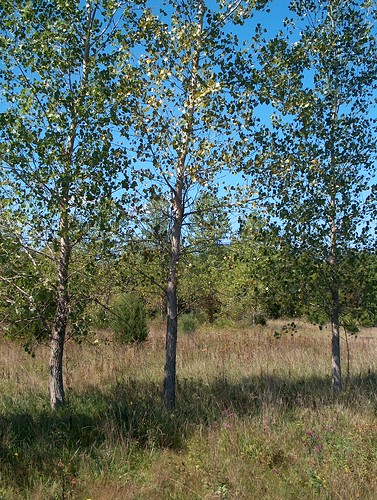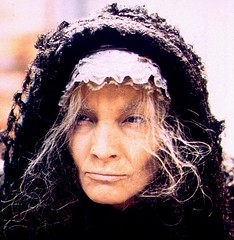
I was interested in the meanings and myths of cottonwood trees because I am now addicted to the one that stands outside the window in my meditation room. The leaves sound like soft rain, and they shimmer and dance almost constantly. I LOVE that tree.
So, here's the scoop on the "lore" surrounding Cottonwood trees, gathered from various sources on the Internet:
The Hidatsa Indians of North America believed that the 'shade' (tree spirit) of the cottonwood (considered by the Hidatsa to be the greatest tree in the valley of the Upper Missouri) if approached with reverence would provide answers to questions and solutions to problems.
The Omaha tribes ascribed mystery to the cottonwood due to its self reliance, ability to reproduce rapidly and to the fact that its leaves resembled water ripples dancing as they rustled gently in the breeze. It was believed that the air was never so still that the leaves were not in motion, even on a hot, still summer afternoon you can hear the gentle rustle of the leaves, at night as well, they rattle and whisper when all else is still. The tribes believed that the winds were the paths of the Sacred Ones and the rustling leaves were a constant reminder of this mystery.
The sacred pole of the Omaha, an object of greatest veneration, was made of cottonwood. This pole seemed to have a similar function as the Ark of the Covenant had for the Hebrews.
Omaha also used personal names pertaining to the tree, names such as Maa ZhoN Hoda meaning Grey Cottonwood.
The cottonwood was called waga chaN by the Dakotas; maa zhoN by the Omaha-Ponca tribes; and natakaaru by the Pawnee.
Comanche held the cottonwood tree sacred - a Tree of Life with it's heart shaped leaves - a gift from Grandfather Peyote.
The young sprouts of the tree were peeled and the inner bark was eaten for its pleasant taste and nutritional value by the Dakotas .
Young and upper branches were used as fodder for horses; the European settlers found this an excellent forage also claiming it was “as good for horses as oats.”
Cottonwood bark was used to roast the clays used in making the paints for heraldic and symbolic painting of the body.
A yellow dye was made from the waxy leaf buds in early spring. The seeds were also boiled to decoct a dye for dipping arrow feathers into.
Native children made toy tipis and toy moccasins from the leaves. The children gathered the fluffy seeds to use as chewing gum like treats. Girls and young women used the leaves as a type of whistle to make a very sweet bird like music; “the effect was most pleasing to the ear.”




.jpg)










6 Comments:
thank you for the cottonwood lore...i love cottonwood trees too...
You're welcome Becky. I might try the chewing gum idea next year when they go to seed again.
Dear Two feathers,
On June 6, 2007, I was almost killed by two beloved giant cottonwood trees in my front yard in North Boulder, Colorado. I had stepped outside at dusk just as a "microburst" hit the trees (and that's all). I sustained a traumatic brain injury and miraculously survived. I am trying to understand if there might be meaning in this experience for me. Thank you kindly. George Peknik
Hi George,
While I can't tell you what your experience might mean to you, I do think that it must mean something! If you ever figure it out, I'd love to hear about it.
Questions I would ask if it happened to me would include something to the effect: did my trees "take the hit" for me? or did they facilitate an experience that was somehow important for me to have? Stuff like that...
Thank you for the cottonwood lore. A friend has a huge one outside his house and I love to sit beneath it and think. It is very peaceful.
Lol so okay, I am just beginning my journey into "paganism" and for a staff and a wand I foind this two perfect Eastern Cottonwood branches that fell in a recent windstorm. Here is the kocker, come mid summer I am extremely allergic to the pollen of this tree. Any thoughts on how this mihht affect any rituals I would do with them?
Post a Comment
I love and appreciate comments - however - comment spam will be deleted when discovered. A big thank you to every one else for taking the time to put your two cents in.